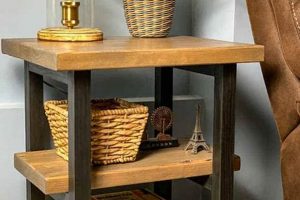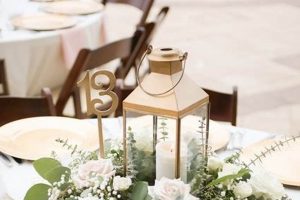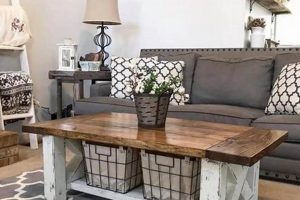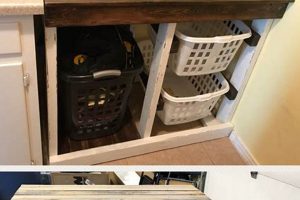The concept encompasses various do-it-yourself projects focused on creating functional and aesthetically pleasing surfaces located adjacent to a bed. These projects involve individuals utilizing readily available materials, repurposed items, or construction supplies to fabricate a personalized piece of furniture for storing bedside necessities like lamps, books, and mobile devices. An instance of this involves transforming a vintage suitcase into a unique storage unit with legs, offering both a surface and enclosed space.
Such endeavors provide several advantages, including cost savings compared to purchasing pre-made furniture, the opportunity to tailor the design to specific bedroom dimensions and style preferences, and the satisfaction derived from creating a functional object. Historically, individuals have customized bedroom furniture to reflect personal tastes and adapt to available resources, evolving from simple stacked crates to more elaborate constructions using woodworking techniques.
This article will delve into various approaches to building your own nightstand, covering topics such as material selection, design considerations for different bedroom aesthetics, and step-by-step instructions for several project examples ranging in complexity and required skill level.
Practical Guidance for Nightstand Construction
The following recommendations are intended to enhance the creation process and ensure the longevity and functionality of self-made bedside furnishings.
Tip 1: Prioritize Ergonomics. The height of the surface should align with the mattress height for easy access to items. Measure the bed’s height before construction commences.
Tip 2: Material Selection Matters. Choose durable and suitable materials based on the desired aesthetic and expected usage. Solid wood, reclaimed timber, or metal components offer varying levels of durability and visual appeal.
Tip 3: Secure Fasteners are Critical. Use appropriate screws, nails, or adhesives designed for the selected materials. Pre-drilling pilot holes prevents wood splitting, ensuring secure assembly.
Tip 4: Consider Weight Distribution. Design the base and support structure to accommodate the intended load. Reinforce joints and stress points for added stability, especially if the nightstand will hold heavy objects.
Tip 5: Implement Cable Management. Integrate solutions for routing charging cables and lamp cords. Drill holes or install clips to conceal wires, maintaining a tidy appearance and preventing tripping hazards.
Tip 6: Apply Protective Finishes. Apply a sealant, stain, or paint to protect the material from moisture, scratches, and wear. Ensure the finish is non-toxic and appropriate for indoor use.
Tip 7: Test Stability Before Use. Once assembled, thoroughly test the nightstand’s stability. Correct any wobbling or structural weaknesses before placing items on the surface.
These guidelines promote successful construction, yielding a functional and enduring piece of furniture. Attention to detail and careful execution contribute to a refined final product.
The subsequent sections will address specific design considerations and project ideas, building upon these fundamental principles.
1. Dimensions
Dimensional considerations are paramount in the successful execution of do-it-yourself bedside furniture. Proper sizing ensures the object integrates seamlessly into the bedroom environment, providing optimal utility and avoiding awkward proportions relative to the bed and surrounding furniture.
- Height Synchronization
The height of the surface must be closely aligned with the mattress height. A surface significantly lower or higher than the mattress creates an uncomfortable reach for items such as books, eyeglasses, or electronic devices. Ideally, the surface should be level with the top of the mattress or slightly above, facilitating easy access without straining.
- Surface Area Appropriateness
The available surface area must accommodate essential bedside items without appearing cluttered or overwhelming the space. A small surface may only hold a lamp, while a larger surface can accommodate a lamp, books, a charging station, and decorative objects. The surface area should be proportional to the room size and the quantity of items intended to be placed on it.
- Depth and Width Considerations
The depth and width impact maneuverability within the bedroom. A nightstand that is too deep may obstruct walkways or limit access to outlets. Conversely, insufficient depth or width may compromise storage capacity and stability, especially if the object has drawers or shelves. Depth and width dimensions should be balanced with available space and storage requirements.
- Leg Height and Ground Clearance
For designs incorporating legs, the leg height affects the overall visual appearance and functionality. High legs create a lighter, more open aesthetic, while low legs provide a grounded, stable feel. Ground clearance, the distance between the floor and the bottom of the structure, should be sufficient to facilitate cleaning and prevent moisture damage, particularly in humid environments.
These dimensional factors collectively influence the usability and visual harmony of the bedside furnishing. Thoughtful consideration of these aspects contributes to a final product that effectively meets both functional and aesthetic requirements within the constraints of the available space.
2. Material Sourcing
The selection and procurement of materials are fundamental to the success of any do-it-yourself bedside table project. Material sourcing dictates the finished product’s structural integrity, aesthetic qualities, and overall cost-effectiveness. The origin and type of material directly influence the table’s durability, its compatibility with the bedroom’s existing dcor, and the environmental impact of the project.
- Reclaimed and Repurposed Materials
Sourcing materials from reclaimed or repurposed sources, such as discarded wood pallets, salvaged doors, or vintage metal components, offers a sustainable and often cost-effective approach. Reclaimed wood imparts a rustic character and reduces demand for newly harvested timber. However, these materials often require careful cleaning, repair, and preparation to ensure structural soundness and safety. An example would be using an old wooden crate as the base for a bedside table, adding legs and a sanded surface for a unique and eco-conscious piece.
- New Construction Materials
Opting for new construction materials, such as dimensional lumber, plywood, or composite boards, provides greater control over material quality and consistency. These materials are readily available at most hardware stores and offer standardized sizes and finishes. However, utilizing new lumber involves a higher initial cost and may necessitate additional cutting and finishing to achieve the desired aesthetic. An example could be using pine boards from a home improvement store to build a simple, modern bedside table with clean lines.
- Hardware and Fasteners
The selection of appropriate hardware and fasteners is crucial for ensuring the structural integrity and longevity of the bedside table. Screws, nails, adhesives, hinges, and drawer slides must be chosen based on the materials being joined and the expected weight load. Inadequate fasteners can lead to instability or premature failure of the table. Brass or iron hardware can add a decorative touch, while hidden fasteners provide a cleaner, more minimalist aesthetic. An example is using heavy-duty screws and wood glue to assemble a solid wood bedside table, ensuring a robust and durable construction.
- Finishes and Coatings
The final step in material sourcing involves selecting appropriate finishes and coatings to protect the bedside table from moisture, scratches, and wear. Paint, stain, varnish, and sealant options vary in terms of their durability, appearance, and application method. Choosing a non-toxic, low-VOC finish is essential for maintaining a healthy indoor environment. A clear sealant can protect the natural beauty of the wood, while a colored paint can coordinate with the bedroom’s color scheme. An example would be applying a water-based polyurethane finish to a painted bedside table, providing a durable and easy-to-clean surface.
The judicious selection of materials, encompassing reclaimed resources to new construction components and appropriate finishes, significantly impacts the final outcome. The source of materials is therefore integral to any do-it-yourself bedside project, influencing not only the appearance, but also the overall sturdiness and environmental footprint of the handcrafted item.
3. Style Compatibility
Style compatibility functions as a pivotal determinant in the success of any do-it-yourself bedside table endeavor. The aesthetic alignment between the newly constructed piece and the existing bedroom design influences the overall harmony and visual appeal of the space. Mismatched styles can disrupt the intended ambiance, creating a discordant and uninviting atmosphere, while conversely, a well-integrated nightstand enhances the room’s cohesive design.
The impact of style compatibility is evident across diverse interior design approaches. In a minimalist bedroom, a sleek, unadorned nightstand constructed from light-colored wood or metal complements the streamlined aesthetic, reinforcing the sense of simplicity and order. Conversely, in a bohemian-inspired bedroom, a repurposed vintage suitcase or a rustic wooden crate serving as a nightstand contributes to the room’s eclectic and personalized character. The absence of such considerations can lead to design clashes, such as placing an ornate, Victorian-style nightstand in a modern, industrial-themed room, resulting in visual disharmony.
Therefore, acknowledging style compatibility is not merely an aesthetic preference but a practical necessity in the realm of do-it-yourself bedside furniture. Careful assessment of the existing room’s design elements including color palettes, furniture styles, and material textures enables informed decisions about the nightstand’s design, materials, and finishes, ultimately contributing to a cohesive and visually pleasing bedroom environment. A unified design scheme creates a more comfortable and relaxing atmosphere.
4. Storage Solutions
Storage solutions are a critical design element within do-it-yourself bedside table projects. The need for storage drives functional requirements, influencing dimensions, material choices, and overall construction approach. A poorly designed storage element reduces the utility of the table, while a well-integrated solution provides convenient access to essential items and enhances the organization of the sleeping space. Examples of storage provisions include drawers for concealed storage of personal items, open shelves for displaying books or decorative objects, and combined configurations offering both concealed and visible storage options. Consequently, careful consideration of storage needs directly impacts the practical success of the build.
The incorporation of effective storage is not limited to simply adding drawers or shelves. A thorough analysis of bedside habits informs storage design. If reading is a regular activity, ample shelving with adequate lighting considerations becomes a priority. If electronic devices are frequently charged overnight, incorporating cable management systems and charging ports within the storage structure ensures convenience and tidiness. Addressing these individual needs streamlines daily routines and enhances the user experience. Furthermore, innovative solutions, such as incorporating hidden compartments or rotating shelves, maximize storage capacity within limited space constraints.
In summary, storage solutions are integral to do-it-yourself bedside table design, impacting both functionality and organization. The degree of storage provision should align with individual needs and bedroom characteristics. Thoughtful integration of storage systems transforms a simple table into a practical and efficient element within the sleep environment, offering ease of access, reduced clutter, and a more comfortable atmosphere.
5. Lighting Integration
The incorporation of lighting within do-it-yourself bedside table projects constitutes a significant design consideration, influencing both the functionality and the aesthetic character of the piece. Thoughtful integration of illumination addresses practical requirements for reading, relaxation, and nighttime navigation, while also contributing to the overall ambiance of the sleeping space. Strategic lighting integration optimizes user experience and enhances the visual appeal of the constructed item.
- Lamp Integration Styles
Various methods exist for integrating lamps into the bedside table design. Traditional approaches involve placing a standalone lamp on the table surface, while more integrated designs include recessed lighting, built-in lamps with adjustable arms, or the incorporation of LED strips along the table’s edges. The choice depends on the desired aesthetic and functional needs. For instance, a minimalist design might favor a recessed LED light, while a more traditional setting may suit a classic table lamp with a fabric shade. Consideration should be given to the lamp’s base size to ensure stability and prevent accidental tipping.
- Power Source and Cord Management
Efficient management of power cords and electrical components is essential for safety and visual appeal. Concealing cords within the table structure, incorporating cable management systems, or utilizing wireless charging technology prevents clutter and reduces the risk of tripping hazards. The placement of electrical outlets should be carefully considered during the design phase to facilitate convenient access to power. Examples include drilling discreet holes in the back of the table for cord passage or integrating a power strip with USB ports into a drawer or compartment.
- Ambient and Task Lighting Considerations
Different types of lighting serve distinct purposes. Ambient lighting provides general illumination, setting the mood of the room. Task lighting, such as a reading lamp, focuses light on a specific area for focused activities. Integrating both types of lighting into the bedside table design enhances functionality and versatility. Dimmer switches offer control over light intensity, allowing for customization of the lighting environment. Examples could be incorporating a low-wattage ambient light source underneath the table for nighttime navigation and an adjustable task lamp for reading.
- Safety and Compliance
Adherence to electrical safety standards is paramount when integrating lighting into DIY projects. All electrical components should be UL-listed or equivalent, and wiring should be performed in accordance with local electrical codes. Proper grounding and insulation are essential for preventing electrical shocks. If unfamiliar with electrical work, consulting a qualified electrician is highly recommended. Examples include using properly rated wiring for the intended voltage and ensuring that all connections are secure and insulated.
Lighting integration is a multifaceted aspect of do-it-yourself bedside table design, encompassing aesthetic choices, functional considerations, and safety protocols. A balanced approach to these elements yields a bedside table that is both visually appealing and functionally efficient, enriching the overall bedroom environment. The selection of appropriate lighting fixtures, coupled with careful installation, ultimately results in an enhanced nighttime experience.
6. Stability & Safety
Stability and safety represent crucial, interconnected facets within the domain of do-it-yourself bedside table construction. A lack of structural stability directly correlates to potential hazards, transforming a functional object into a source of injury. This relationship manifests in scenarios such as a poorly constructed table collapsing under the weight of its contents, leading to damage or personal harm. Similarly, sharp edges, protruding fasteners, or unstable legs can create tripping hazards or cause lacerations. Therefore, the inherent stability and safety attributes of self-constructed bedside tables are not merely desirable features but essential prerequisites for responsible and effective implementation.
Achieving adequate stability necessitates careful consideration of design and construction techniques. Employing robust materials, secure fastening methods, and a well-engineered structural framework serves to minimize the risk of collapse or tipping. For instance, mortise-and-tenon joints or metal brackets can enhance the strength of wooden structures. Furthermore, safety considerations demand attention to details such as rounding sharp edges, countersinking screws, and applying non-slip pads to the base of the legs to prevent sliding. A real-world example involves a table constructed with inadequately sized legs that buckles under the weight of a lamp and books, underscoring the tangible consequences of neglecting stability during design and assembly.
In summary, the stability and safety of self-made bedside tables are interdependent, directly impacting their utility and potential for harm. Prioritizing sound construction practices, careful material selection, and attention to detail are essential for mitigating risks and ensuring a functional and safe addition to the bedroom environment. The commitment to these principles transforms the project from a simple crafting activity into a responsible endeavor that contributes positively to the well-being of the user.
Frequently Asked Questions Regarding DIY Bedside Table Ideas
The following questions address common concerns and misconceptions associated with creating bedside tables through do-it-yourself methods. The provided answers aim to offer clarity and practical guidance.
Question 1: What fundamental tools are necessary for constructing a simple bedside table?
Essential tools include a measuring tape, saw (hand saw or power saw), drill with various drill bits, screwdriver (or drill with screwdriver bits), sandpaper, and safety glasses. Additional tools may be required depending on the complexity of the design and materials used.
Question 2: How does one ensure structural integrity in a self-made bedside table?
Structural integrity is achieved through proper joint construction (e.g., mortise and tenon, dowel joints), appropriate fastener selection (screws, bolts, and adhesives), and the use of materials with adequate load-bearing capacity. Reinforcing corners and stress points is also recommended.
Question 3: What safety precautions should be observed during the construction process?
Safety precautions include wearing safety glasses to protect against debris, using hearing protection when operating power tools, ensuring adequate ventilation when working with paints and adhesives, and following all manufacturer’s instructions for tool operation and material handling.
Question 4: How does one effectively manage electrical wiring when incorporating lighting into a bedside table?
Electrical wiring should be performed in accordance with local electrical codes. Employ UL-listed components, utilize proper grounding techniques, and ensure all connections are secure and insulated. If lacking expertise in electrical work, consulting a qualified electrician is strongly advised.
Question 5: What are common mistakes to avoid when undertaking a DIY bedside table project?
Common mistakes include inaccurate measurements, inadequate material preparation, improper joint construction, neglecting safety precautions, and failing to consider the table’s intended use and weight-bearing requirements. Meticulous planning and attention to detail mitigate these risks.
Question 6: How does one select appropriate materials for a durable and aesthetically pleasing bedside table?
Material selection depends on the desired aesthetic, budget, and skill level. Solid wood offers durability and visual appeal, while plywood and MDF provide cost-effective alternatives. Consider the material’s weight, resistance to moisture, and ease of finishing. Sourcing sustainable or reclaimed materials is an environmentally conscious option.
Successful implementation of do-it-yourself bedside furniture hinges on meticulous planning, diligent execution, and adherence to safety standards. Careful attention to detail yields a functional and aesthetically satisfying result.
The next section will explore diverse project ideas, ranging from simple repurposed designs to more complex woodworking constructions.
Concluding Remarks on diy bedside table ideas
This examination of “diy bedside table ideas” has presented various facets of the design and construction process, emphasizing dimensional considerations, material sourcing, style compatibility, storage solutions, lighting integration, and ensuring stability and safety. These elements are pivotal in crafting a functional and aesthetically suitable bedside furnishing. The provided guidelines, tips, and addressed frequently asked questions equip individuals with the knowledge required for successful project execution.
Ultimately, the realization of these projects hinges on meticulous planning and execution. The construction of a bedside table, when approached with deliberate intention and informed knowledge, offers both practical utility and a personalized element within the bedroom environment. The pursuit of such projects promotes resourcefulness and fosters individual expression.







